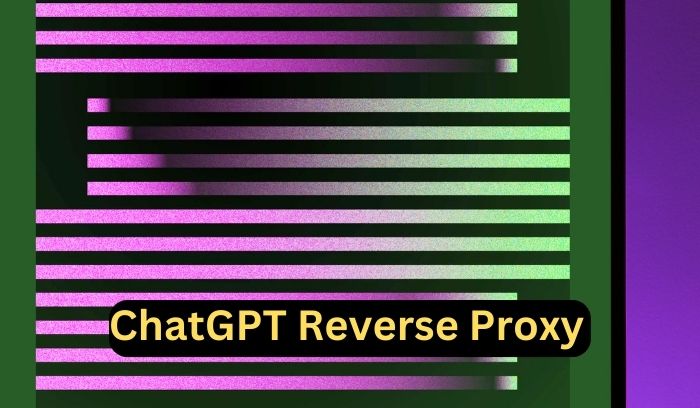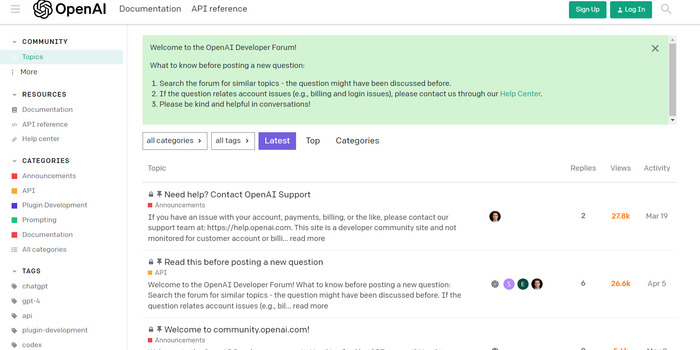If you are a tech enthusiast then definitely you’ve heard about ChatGPT Reverse Proxy.
But when you search on the internet about this term, you did not get any proper information.
Because there are a lot of websites that write about this but do not properly elaborate on this outstanding method to access OpenAI for free.

For that reason, I am here to elaborate what is ChatGPT reverse proxy and everything you need to know about it.
Now, without wasting any time, let’s dive into it.
What Is ChatGPT Reverse Proxy?
ChatGPT reverse proxy is a method that allows everyone to access the OpenAI API key for completely free or with different features using a proxy server.
The OpenAI API is a powerful tool that provides access to OpenAI’s language models, such as GPT-3 or 3.5 and you can use it for your own service or product.
Suppose, you run an e-commerce site where you can integrate OpenAI API to answer your customers’ general queries.
But if you choose to use this API by using the direct method, then you need to pay a monthly subscription.
On the other hand, when you choose ChatGPT reverse proxy, you can access it for free in 2024.
This is why Chat GPT reverse proxy is a very popular term among tech enthusiasts.
If you want to use it for free then-
There are some open-source ChatGPT reverse proxy projects available on GitHub, such as PawanOsman/ChatGPT and acheong08/ChatGPT.

These projects provide an easy way for developers or AI enthusiasts to use ChatGPT Reverse Proxy and build their own applications that utilize the OpenAI API.
It is important to note that using a reverse proxy may violate OpenAI’s terms of service, and it should be used with caution.
Benefits Of Using ChatGPT Reverse Proxy Key
ChatGPT Reverse Proxy Key is an essential tool for managing traffic and requests sent to the ChatGPT API. It acts as a gateway, optimizing performance, and ensuring that the ChatGPT API is used efficiently and securely.
Here are some of the primary benefits of using ChatGPT Reverse Proxy Key.
Enhanced Security
One of the most significant benefits of using ChatGPT Reverse Proxy Key is enhanced security.
The reverse proxy acts as a buffer between the client and the server, protecting the server from malicious attacks.
It also allows for the implementation of security measures such as SSL encryption, which ensures that all data transmitted between the client and the server is secure.
Improved Performance
Another benefit of using this Key is improved performance. The reverse proxy can cache frequently requested content, reducing the number of requests sent to the server.

This results in faster response times and a more efficient use of server resources.
Scalability
ChatGPT Reverse Proxy Key also offers enhanced scalability. It can distribute traffic across multiple servers, ensuring that the load is evenly distributed and that no single server becomes overloaded.
This allows for the seamless scaling of the ChatGPT API, ensuring that it can handle increased traffic as needed.
Data Protection
Reverse proxies can provide an additional layer of security by masking the origin server’s IP address and blocking direct access to it.
This makes it more difficult for attackers to target the server and steal sensitive data.

Additionally, reverse proxies can also provide protection against DDoS attacks by blocking traffic from suspicious sources.
Load Balancing
Another advantage of using a reverse proxy with ChatGPT is load balancing. Reverse proxies can distribute incoming traffic across multiple servers, ensuring that no single server is overloaded.
This can help improve the overall performance of the ChatGPT API by preventing any one server from becoming a bottleneck.
SSL Encryption
Reverse proxies can also provide SSL encryption, which can help protect data in transit.
SSL encryption ensures that any data sent between the client and server is encrypted and cannot be intercepted or read by unauthorized parties.

This can help protect sensitive data, such as user credentials or payment information.
In summary, using a reverse proxy with ChatGPT can provide several advantages, including data protection, load balancing, and SSL encryption. These benefits can help improve the overall performance and security of the ChatGPT API.
How To Set Chat GPT Reverse Proxy?
Here is a step-by-step process to set up a GPT reverse proxy:
1. Choose a reverse proxy software: The first step is to choose a reverse proxy software like Nginx, Apache, or HAProxy. For this example, we will use Nginx.
2. Install Nginx: Install Nginx on your server by following the installation instructions for your operating system.
3. Configure Nginx: Once Nginx is installed, you need to configure it to act as a reverse proxy. This involves setting up rules to direct traffic. Here is an example configuration file for Nginx:
server {
listen 80;
server_name example.com;
location / {
proxy_pass http://openai-api-endpoint;
proxy_set_header Host $host;
proxy_set_header X-Real-IP $remote_addr;
proxy_set_header X-Forwarded-For $proxy_add_x_forwarded_for;
}
}Replace `example.com` with your domain name and `openai-api-endpoint` with the endpoint for the OpenAI API you want to use.
4. Test the reverse proxy: Start Nginx and test the reverse proxy by sending a request to your domain name. If everything is set up correctly, Nginx should forward the request to the OpenAI API and return the response.
5. Use the reverse proxy: Once the reverse proxy is set up and tested, you can use it to access the OpenAI API for text completion (ChatGPT) and image generation (DALL-E).
To use the reverse proxy, send requests to your domain name instead of the OpenAI API endpoint.
That’s it! You have successfully set up a GPT reverse proxy using Nginx.
And there is another way to get a GPT reverse proxy key and you can use it to access Janitor AI or other tools.
Resources for Chat GPT Reverse Proxy
If you’re looking for resources to help you implement GPT reverse proxy into your chatbot, there are several options available.
One of the best places to start is the official GPT-3 documentation. It provides a detailed guide on how to use GPT-3 with reverse proxy, including sample code and best practices.
Another great resource is the GPT-3 community forum, where developers can share their experiences and ask for help.

The forum is a great place to find answers to common questions and connect with other developers who are working on similar projects.
And also there are several online courses and tutorials available to learn ChatGPT reverse proxy resources.
For example, Udemy offers a course on “NGINX Master Class,” which covers everything from setting up the environment to deploying the chatbot.
Additionally, there are several YouTube tutorials that cover GPT-3 and reverse proxy in detail.

Finally, if you’re looking for a more hands-on approach, there are several open-source projects available on GitHub, we mentioned before.
These projects provide sample code and templates that you can use to build your own chatbot with GPT-3 and reverse proxy.
Use Cases Of ChatGPT Reverse Proxy
There are several use cases for ChatGPT reverse proxy that can help businesses improve their customer service and engagement.
Customer Service
One of the most common use cases for ChatGPT reverse proxy is customer service. By implementing GPT models into chatbots, businesses can provide 24/7 customer support without the need for human agents.

Lead Generation
Another use case for ChatGPT reverse proxy is lead generation. Chatbots can be programmed to engage with potential customers and provide them with relevant information about products or services.
Chatbots can provide personalized recommendations that are tailored to the customer’s needs, increasing the chances of converting a lead into a sale.
Employee Training
ChatGPT reverse proxy can also be used for employee training and development. Chatbots can provide employees with on-demand training and support, helping them improve their skills and knowledge.
Marketing and Advertising
Finally, this proxy can be used for marketing and advertising. When you use GPT models in your chatbots, they can provide targeted marketing messages to the potential customers that are more likely to convert into a sale.

Risks Of Using ChatGPT Reverse Proxy
Here are some of the risks of using ChatGPT Reverse Proxy:
Impersonation and manipulation: A malicious/hacker could use the chatbot to create fake identities and content and use a reverse proxy to hide their true location and identity.
Data disclosure: ChatGPT uses much data, including sensitive and confidential information. However, this data could be exposed or leaked through a reverse proxy.
Accountability and legal repercussions: If someone uses ChatGPT Reverse Proxy to create harmful content, it can be difficult to trace back to the original user.
Security vulnerabilities: Reverse proxies can introduce security vulnerabilities into a system. If a reverse proxy is not properly configured, it could be used to exploit security flaws in the underlying system.
Forward Proxy vs Reverse Proxy: What’s The Difference?
Forward proxy and reverse proxy are two types of proxy servers that serve different purposes and are used in different contexts.
Generally, a proxy server is referred to as a forward proxy, that’s why this comparison also mentions proxy vs. reverse proxy.
However, here’s a short explanation of each and their differences:
Forward Proxy
A forward proxy, also known as a client-side proxy, plays a crucial role in helping users or client applications access internet resources seamlessly. Here’s a simplified explanation of how it works:
1. Client’s Request: When a client (e.g., a user or an application) wants to access a web page or file from the internet, it initiates a request.
2. Forward Proxy Intermediary: Instead of directly reaching out to the internet server, the client’s request is sent to the forward proxy server first.
3. Proxy Forwarding: The forward proxy then acts as a mediator on behalf of the client, forwarding the request to the internet server.
4. Internet Server Interaction: The internet server processes the request, responding to the forward proxy—without any knowledge of the client’s identity.
5. Response to Client: The forward proxy receives the internet server’s response and relays it back to the client.
Advantages of Forward Proxy
Now you have the idea of what a forward proxy is and how it works. So, after using a forward proxy for your project, you will get some benefits which are given below:
- Privacy: The client’s identity remains hidden from the internet server, enhancing privacy and security.
- Caching: The proxy can cache frequently requested resources, reducing response times and conserving bandwidth.
- Content Filtering: It allows administrators to control and filter internet content for the clients.
- Bandwidth Control: Forward proxies can manage and optimize network traffic, ensuring a smoother browsing experience.
Reverse Proxy
A reverse proxy, often referred to as a server-side proxy, plays a vital role in optimizing server performance and enhancing security. Reverse proxy is not like a traditional proxy server, which is mainly used to protect clients. And in this case, the reverse proxy is used to protect the server, not clients.
Let’s break down the concept of reverse proxy in seven easy steps:
1. Client Interaction: When clients (users or applications) send requests to access resources from a server, these requests are directed to the reverse proxy server first.
2. Server Intermediary: Acting as a powerful intermediary, the reverse proxy takes on the responsibility of handling client requests on behalf of the server.
3. Request Routing: The reverse proxy intelligently routes each client request to the appropriate backend server within the network. It acts as a smart dispatcher, directing traffic efficiently.
4. Load Balancing: In cases of high traffic or server loads, the reverse proxy efficiently distributes incoming requests among multiple backend servers. This process is known as load balancing, ensuring optimal resource utilization.
5. Server Protection: By shielding backend servers from direct exposure to the internet, the reverse proxy enhances security. Clients interact solely with the reverse proxy, keeping the servers’ identities hidden.
6. Caching and Performance: The reverse proxy can cache frequently accessed resources, reducing response times for subsequent requests. This caching mechanism improves overall performance and reduces server load.
7. SSL Termination: The reverse proxy can handle SSL/TLS encryption and decryption, offloading this resource-intensive task from the backend servers. This improves the server’s efficiency in handling secure connections.
Reverse Proxy Advantages
- Security Enhancement: Protects backend servers from direct exposure to potential threats, bolstering the overall security posture.
- Scalability: Enables seamless scaling by distributing incoming requests among multiple servers, preventing overload situations.
- Performance Optimization: Caching and load balancing mechanisms ensure faster response times and smoother user experiences.
- Application Firewall: Some reverse proxies include application firewall features, adding an extra layer of protection against web attacks.
Now you have the basic idea between Forward Proxy and Reverse Proxy. RIGHT?
Now if you want more details on that then here is a table comparing the different proxy.
Forward Proxy vs Reverse Proxy: Based On Features
| Feature | Forward Proxy | Reverse Proxy |
| Direction | Handles outbound requests on behalf of clients. | Handles inbound requests on behalf of servers. |
| Use Case | Anonymity, content filtering, caching for clients. | Load balancing, SSL termination, security. |
| Functionality | Filters and forwards client requests to servers. | Distributes requests among backend servers. |
| Client Awareness | Transparent to clients. | Aware of clients and servers. |
| Server Awareness | Unaware of backend servers | Aware of backend servers |
| SSL Termination | Not involved in SSL termination | Can terminate SSL and initiate new SSL links |
| Security | Adds an additional layer of security for clients | Acts as a shield for backend servers |
| Examples | Squid, Proxy, Tor | Apache, Nginx, and Caddy |
FAQs Around Chat GPT Reverse Proxy
What is a ChatGPT reverse proxy?
A ChatGPT reverse proxy serves as a bridge between users and the ChatGPT language model on the server-side. Essentially, it acts as an intermediary, taking user requests, passing them on to the language model for processing, and then relaying the model’s responses back to the users.
Why would I need a reverse proxy for ChatGPT?
Having a reverse proxy for ChatGPT comes with several advantages. Firstly, it helps manage the workload on the language model by efficiently handling multiple user requests at once.
Secondly, it adds a layer of security by creating a buffer between the model and direct user interactions. Moreover, a reverse proxy allows for customization and seamless integration with other systems or services.
How does a ChatGPT reverse proxy work?
The ChatGPT reverse proxy is designed to listen for incoming user requests and establishes a connection with the ChatGPT model to process those requests.
It takes care of user authentication, rate limiting, and input validation before forwarding the requests to the actual model. Once the model generates a response, the reverse proxy sends it back to the user.
What are some use cases for a ChatGPT reverse proxy?
A ChatGPT reverse proxy finds applications in various scenarios, such as customer support chatbots, virtual assistants, or conversational interfaces for applications and websites.
It can be a valuable tool for businesses seeking to automate interactions, enhance user experience, and provide round-the-clock support.
How can I get started with building a ChatGPT reverse proxy?
To begin building a ChatGPT reverse proxy, you can explore the available frameworks, libraries, and resources that are specifically designed for creating conversational AI applications.
Start with simple prototypes to get a feel for the process and gradually expand your implementation as you gain more expertise.
Additionally, engaging with developer communities and forums focused on conversational AI will help you learn from others and stay informed about best practices.
What are the security considerations when using a ChatGPT reverse proxy?
Deploying a ChatGPT reverse proxy demands careful attention to security. Crucial measures include implementing robust user authentication, rate limiting mechanisms to prevent abuse, input validation to safeguard against malicious inputs, and secure communication protocols like HTTPS.
Regularly updating and patching the reverse proxy and underlying infrastructure is also vital to maintain a secure environment.
Conclusion
In conclusion, ChatGPT Reverse Proxy is a method that allows free access to the OpenAI API key using a proxy server. It offers benefits such as enhanced security, improved performance, scalability, data protection, load balancing, and SSL encryption.
However, caution must be exercised as its usage may violate OpenAI’s terms of service. Developers can set up ChatGPT Reverse Proxy by referring to available resources, including documentation, forums, courses, tutorials, and open-source projects.
This technology finds applications in customer service, lead generation, employee training, and marketing. It is important to consider risks such as impersonation, data disclosure, accountability, and security vulnerabilities.
